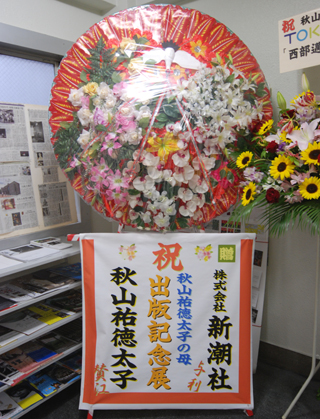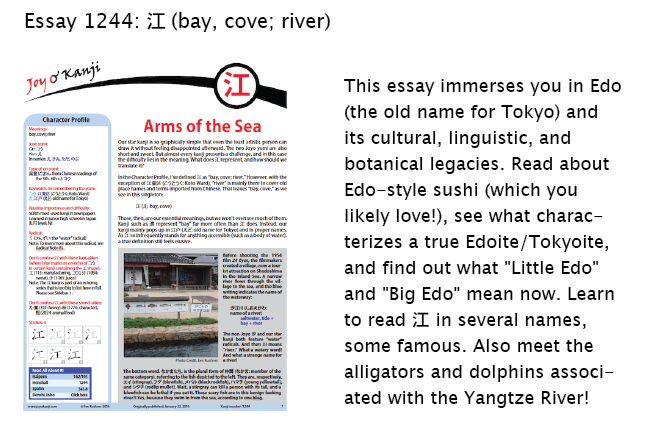No Mere Afterthought
If you saw this sign, would you know what to make of it?

Here is the biggest writing in the columns from right to left:
株式会社 新潮社
秋山祐徳太子の母
出版記念展
秋山祐徳太子
It all probably looks like a lot of nothing still, right? Let me make it a bit more meaningful by providing context. The sign pertains to a wreath (輪, はなわ: "flower ring") that a book publisher has given an author to celebrate 祝 (しゅく) the publication of his book. The various columns give us details about all that. Let's start with the "bookends":
Column 1 (black), the publisher's name:
株式会社 新潮社
Shinchosha, Inc.
株式会社 (かぶしきがいしゃ: public company);
新潮社 (しんちょうしゃ: Shinchosha)
Column 4 (black), the author's name:
秋山祐徳太子* (あきやま ゆうとくたいし)
Born in 1935, this man is an engraver, photographer, and occasional politician.
Now for the middle parts:
Column 2 (blue), the book title:
「秋山祐徳太子の母」
Yutokutaishi Akiyama's Mother
母 (はは: mother)
Column 3 (yellow):
出版記念展
Exhibition Commemorating the Publication of the Book
出版 (しゅっぱん: publication); 記念 (きねん: commemoration); -展 (-てん: exhibition)
Now that we've squared all that away, I can focus on what I want to point out about the sign. To me, the most valuable aspect is exactly what the eye would naturally skip over, as it's written like an afterthought. Look at the orange writing near the bottom of the "bookend" columns:
与利
賛江
It's hard to make sense of these, right? That's because they're ateji and simply mean "from" and "to" respectively! That is, the wreath is from the publisher, to the author. Here's how it all works, as I've explained in the new essay 1244 on 江 (bay, cove; river):
Some banners (such as the one above) have this sort of statement (even if the orange writing doesn't appear to form a unified phrase):
AよりBさんへ
From person A to person B
The Japanese often represent these particles with kanji, all of which are ateji:
AよりBさんへ
A与利B賛江
So 与利 stands for より, which makes sense; 与 and 利 are where the hiragana よ and り come from respectively. Meanwhile, 賛 (which has the Joyo on-yomi of サン) represents the さん that follows people’s names. And 江 (which has the Joyo kun-yomi of え) is a substitute for へ (to, for).
In another example, the left-hand wreath has a sign underneath. Here’s the bit down the left:
かもめ食堂さん江
for Kamome Restaurant
食堂 (しょくどう: restaurant)
And as good things come in threes (or is that bad things?!), you can check one more sign, which says this:
木村多江さん江
for Tae Kimura
木村多江 (きむら たえ: name of an actress)
Oh! I just noticed that this line has two instances of 江, the newest kanji in my corral of essays! That duplication just shows how important 江 can be! You can find out much more about this kanji in the richly illustrated essay 1244 on 江 (bay, cove; river). Here's a sneak preview:

Have a great weekend!

Comments